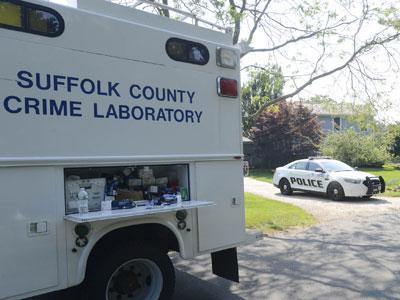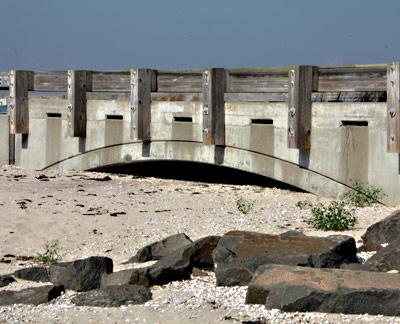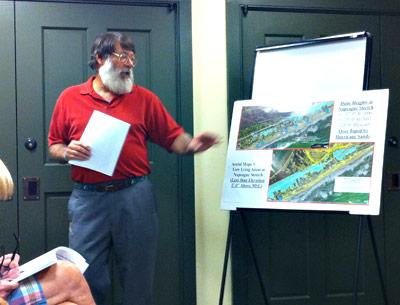Taking Long View on Wastewater
Taking Long View on Wastewater
A kick-off meeting to outline the development of an East Hampton Town comprehensive wastewater management plan, which will include plans for surface and groundwater quality protection and monitoring, as well as recommendations for optimum septic waste treatment, and the future of the town’s scavenger waste plant, was held Monday at Town Hall.
The effort, said Dominick Stanzione, follows along in East Hampton’s “long history of environmental progressivity” and will be a “very important, groundbreaking study.” The town councilman has stressed the need for a long-range, science-based plan, and is one of three board members who voted to approve the nearly $198,000 contract with the consultants who will prepare it.
Pio Lombardo of Lombardo Associates, a Massachusetts firm that has developed its own septic system, along with Kevin Phillips and Stephanie Davis of FPM Group of Ronkonkoma, who specialize in hydrogeology, will work with others from the Woods Hole Group, also in Massachusetts, to address the three main elements of the plan.
They will investigate and present to the town the “science and engineering issues” involved in decisions about wastewater management and water protection, Mr. Lombardo said at the meeting on Monday, and will provide options, recommendations, and cost estimates for future decision-making by town officials.
The plan has been at the center of a political tug of war among board members, with Town Supervisor Bill Wilkinson and Councilwoman Theresa Quigley remaining adamantly opposed to it. They have insisted instead that the board should have approved a lease, then sale, almost two years ago of the scavenger waste plant to ClearFlo Technologies, a private company with which the sale had been discussed.
Mr. Wilkinson attended Monday’s information session; Ms. Quigley did not. But the course of action set by Mr. Stanzione, along with Councilwoman Sylvia Overby and Councilman Peter Van Scoyoc, appeared to be making continued waves.
Several speakers at the meeting asked pointed questions of Mr. Lombardo about whether the ultimate result of the planning process would be a requirement that individual homeowners spend their own money to upgrade septic systems, and if the consultants’ recommendations might include the use of Nitrex, the high-technology nitrogen-removal system developed by Lombardo Associates.
“Is this whole thing a mandate, or just suggestions?” asked Pat Flynn of Montauk. “I am an American. Is this involving my liberty? Is someone going to walk on my property and look at my cesspool, because that I’m saying no to. I’m defending my land and my American rights.”
“Nobody’s going to violate your rights,” Mr. Lombardo said. A lot-by-lot examination of septic systems is not planned, he said, and would have to be authorized by the town board.
Should the town’s ultimate plan call for upgrades to sub-par residential septic systems, the town board would determine how those might be financed.
“We have a collective problem of protecting our groundwater,” said Peter Wadsworth, a member of the town’s budget and finance advisory committee, “and the town as a whole is going to bear that cost. We all benefit from solving that problem.” He said there are numerous ways, including bond issues, to cover the costs of agreed-upon septic solutions that would avoid an onerous burden on individual taxpayers.
Carole Campolo, a Springs resident, raised several issues about the hiring of Mr. Lombardo, as she has at other recent board meetings.
In an e-mail sent around last week, Ms. Campolo urged residents to attend Monday’s kickoff meeting on the septic management plan, which she said is “being pushed by the ‘Agenda 21’ crowd.”
She was apparently referring to a United Nations action plan stressing sustainability, smart growth, and environmental protection, which has become a target for political conservatives who liken it to social engineering.
In his magazine, Blaze, the conservative political commentator Glenn Beck has called it a “global scheme that has the potential to wipe out freedoms of all American citizens.” He used the Agenda 21 name as the title of his dystopian novel, in which suburban and rural homeowners are stripped of their property rights by the government.
In her e-mail, Ms. Campolo said that, in her opinion, the contract for creation of a wastewater management plan is “designed to . . . ultimately require each and every household to install the Nitrex system” at a cost of $20,000 to $30,000 per household.
She called the bidding process that resulted in awarding the contract for creating the wastewater management plan to Mr. Lombardo, FPM, and the Woods Hole Group, “flawed at best,” and warned, in a reference to a solar energy company that went bankrupt after receiving federal stimulus funds, that “this contract could become East Hampton’s Solyndra.”
She warned recipients who are not residents of East Hampton that, “if this contract gets a foothold in East Hampton, it will definitely spread to other hamlets and towns.”
The Nitrex system is one of four septic systems accepted for use by the County Health Department. In independent evaluations, including by the Environmental Protection Agency, it has been determined to reduce the pollutant nitrogen in wastewater to the lowest levels, compared to other technologies.
Mr. Lombardo pointed out in his presentation on Monday that nitrogen pollution is not a potential problem in a good portion of the town — the area south of a groundwater divide running lengthwise roughly through the center of East Hampton. There is a potential for nitrogen pollution north of the groundwater divide, but, he said, at present the lack of a growth of “excessive harmful algae” would indicate that nitrogen is not the issue. Based upon preliminary investigations, he said, he does not expect to be making recommendations for the widespread installation of any nitrogen removal system.
However, if any Nitrex systems are to be installed as a result of the overall wastewater management plan, Mr. Lombardo will not benefit financially from the sales. In addition, he said, he would expect town officials to subject recommendations for specific treatment systems to a review by other experts in the field.
On Monday afternoon, Mr. Lombardo provided a copy of a “conflict of interest statement” he signed, which he said is standard for all his contracts. It states that “should there be a need for wastewater and groundwater nitrogen removal systems in East Hampton,” with Nitrex’s capabilities, Lombardo Associates would receive no royalties.
“Virtually all” technological consultants “have proprietary technology,” and such agreements are in no way out of the norm, Mr. Lombardo said.
In this case, in response to questions by members of the town board, the consultant also provided a letter reiterating the agreement that the company would only receive consulting fees from its contract with the town, eliminating a financial incentive to recommend the use of the Nitrex system.
Kim Shaw, the town’s natural resources director, said that the choice of consultants was made through a blind rating process, using a matrix of criteria, by a committee including representatives from the town’s Engineering, Planning, Finance, Aquaculture, and Natural Resources Departments, as well as the town attorney’s office.
After independent scores by each committee member were averaged, the group that was ultimately hired received the highest rating, based on the established criteria.
The plan calls for the establishment of a citizens’ project advisory committee, another bone of contention raised by Ms. Campolo, who said in her e-mail that she would like to be appointed, but that Mr. Lombardo is opposed. There should be a “representative group of citizens,” she wrote.
The advisory committee is to be appointed by the town board. In an e-mail to The Star on Tuesday, Mr. Lombardo wrote that the consultants have “no objections or opinions on any candidates.”
The wastewater management plan is expected to be finished in January. Consultants will focus on needs analysis and defining alternatives for various areas of town over the next two months, beginning with Montauk in September. Public meetings will be held monthly for discussion and review, with remote participation through e-mail and telephone included, and will be streamed live on the town’s public access provider, LTV. Reports on various elements of the project will be issued periodically.
A Web site, at EHWaterRestore.com, will include information and documents, and afford the public an opportunity to submit questions and comments.
“Any future action will be decided by the town board in January,” when the consultants’ work has been completed, Mr. Lombardo said on Monday. “All we’re going to do is present the factual information.”








